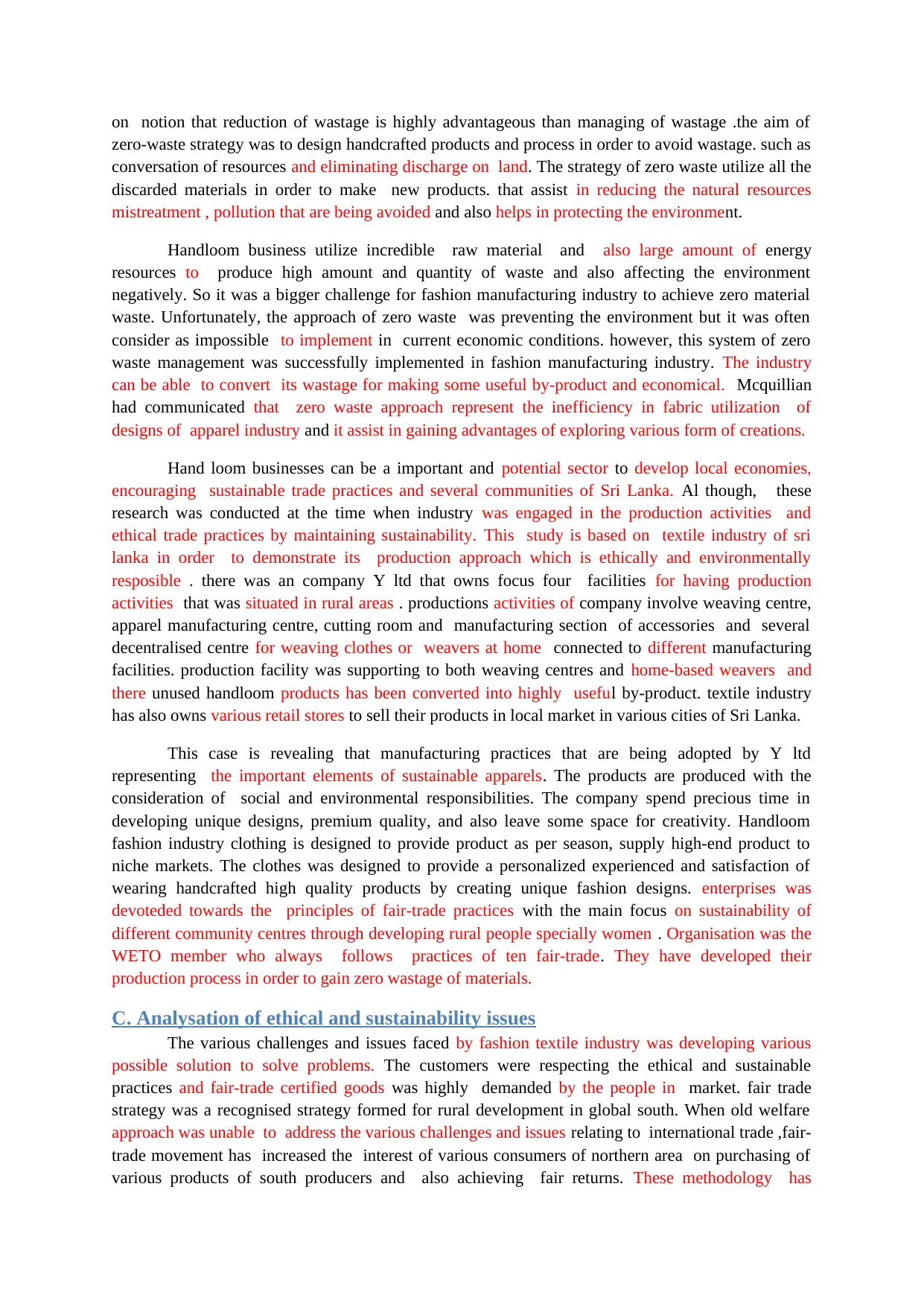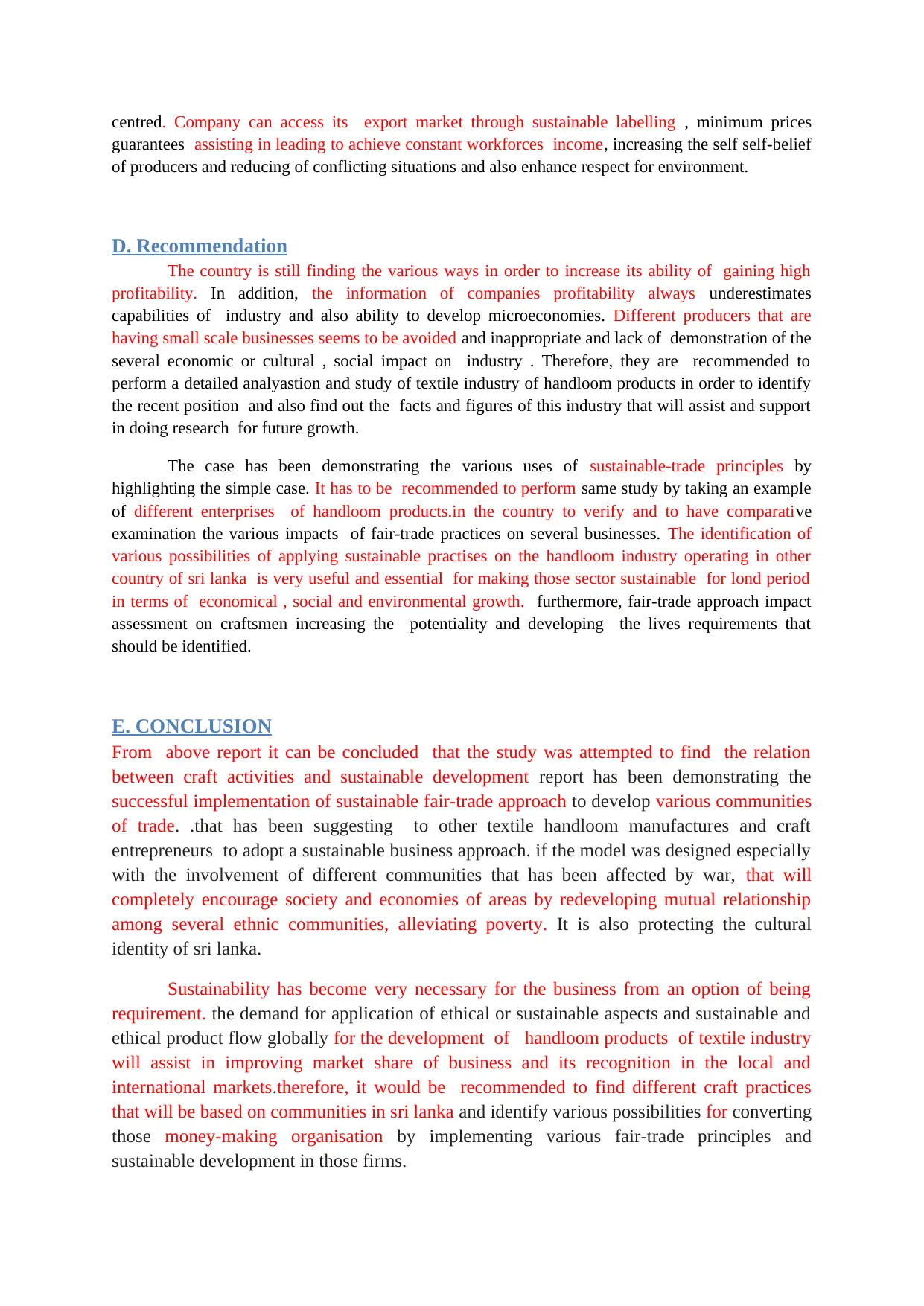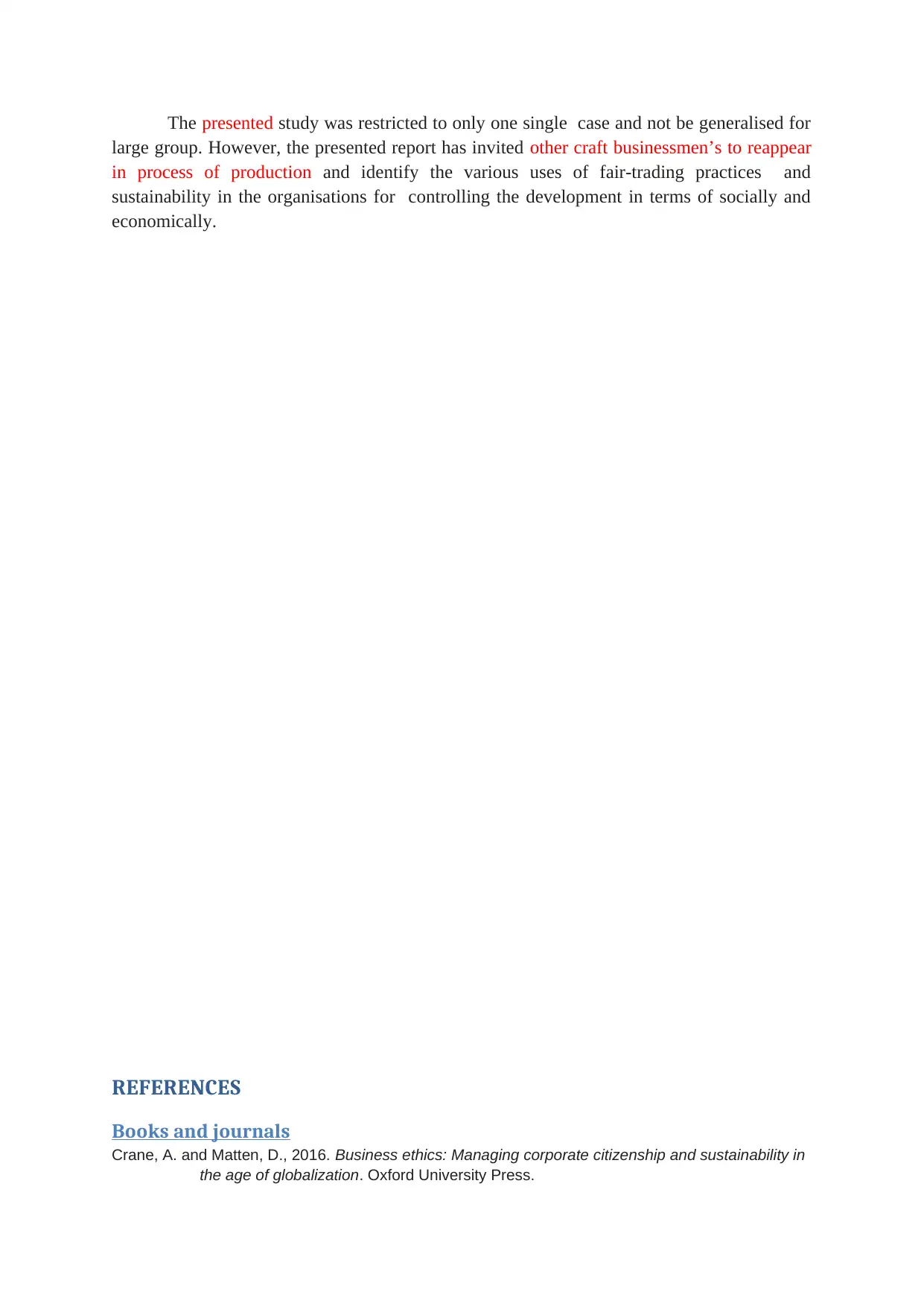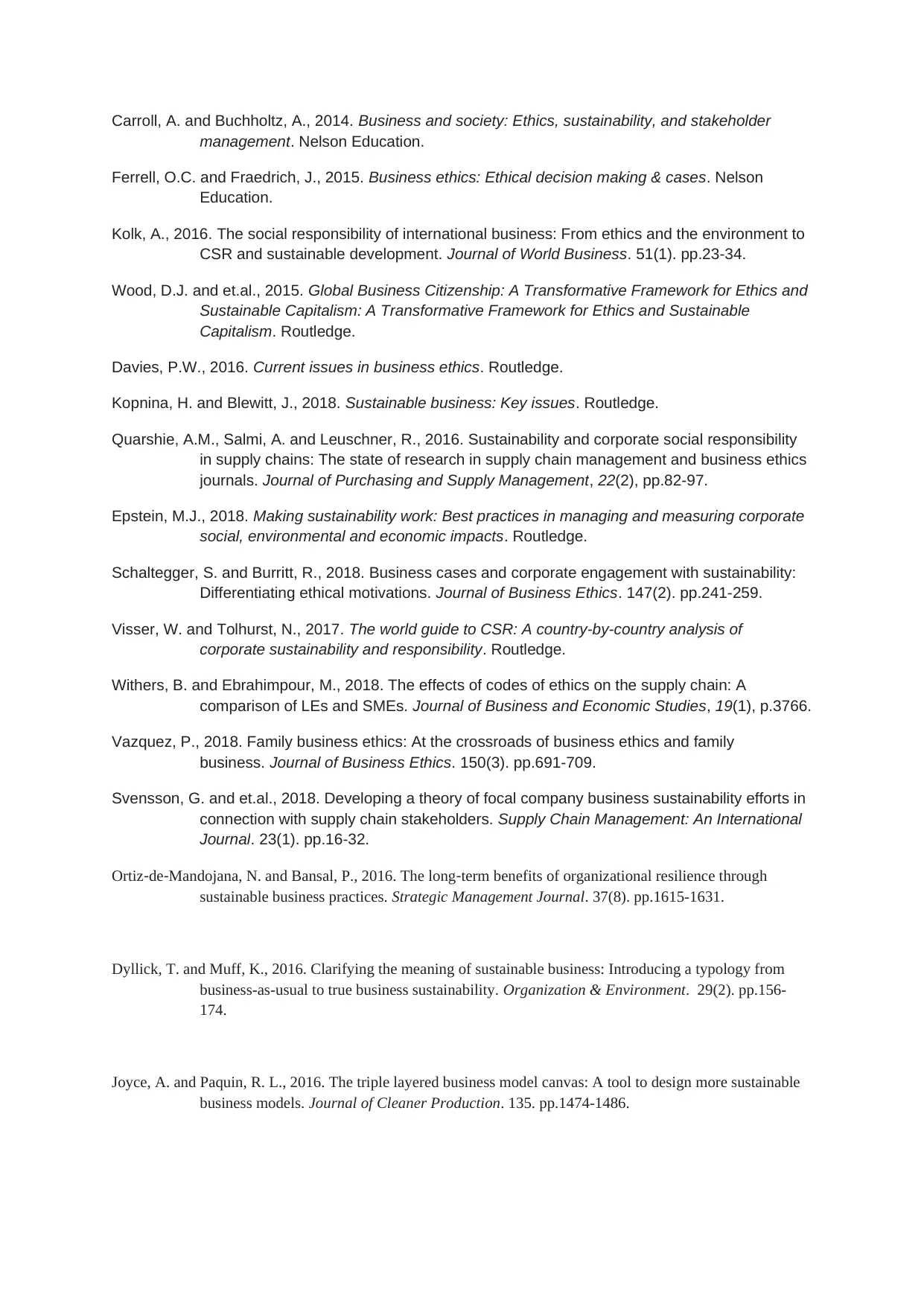Business ethics and sustainability | Assignment
VerifiedAdded on 2021/01/02
|16
|3780
|118
AI Summary
Contribute Materials
Your contribution can guide someone’s learning journey. Share your
documents today.

Case study report of a
current ethical and/or
sustainability issue in
business.
Contents
current ethical and/or
sustainability issue in
business.
Contents
Secure Best Marks with AI Grader
Need help grading? Try our AI Grader for instant feedback on your assignments.

A. INTRODUCTION.............................................................................................................................3
B.Detailed description of case...........................................................................................................3
C. Analysation of various issues of ethics and sustainability of business.........................................5
D. Learnings from the case................................................................................................................7
E. summarisation of the case.............................................................................................................7
Source of information............................................................................................................................8
A. INTRODUCTION
Global fashion industry has a very harsh evidence the environmental and social
implications that are associated with waste generation .growing customers awareness relating
to environmental and social impact of fashion of fashion product has created a fresh market.
B.Detailed description of case...........................................................................................................3
C. Analysation of various issues of ethics and sustainability of business.........................................5
D. Learnings from the case................................................................................................................7
E. summarisation of the case.............................................................................................................7
Source of information............................................................................................................................8
A. INTRODUCTION
Global fashion industry has a very harsh evidence the environmental and social
implications that are associated with waste generation .growing customers awareness relating
to environmental and social impact of fashion of fashion product has created a fresh market.

for ethical or sustainable goods. Case study is based on Sri Lanka handloom textile industry,
the report has explored a production approach which is committed to designed to waste
management. the study reveals a model of business that is positively contributing towards
sustainable household income for rural people and providing various employment
opportunities. This report is highlighting that this kind of environmentally conscious
production process and fair trade is addressing three basis of sustainability i.e. social,
economic, environmental. The manufacturer should redesign the current fashion production
system for waste management issues are hindering the sustainability. The handloom industry
has faced the biggest problem of growing waste that are associated with environmental and
social impact. When this wastage was dumped in in open surroundings it causes various
health and environmental issues. due to which industry was facing monetary lost in two
stages: at the stage of procurement of raw material, at the time of high wastage incurred after
production process. which was affecting the overall productivity and profitability of industry.
Waste is also representing the inefficiency manufacturing process. due to which industry was
facing a big problem of monetary loss.
B.Detailed description of case
Sustainability can be explained in several ways in case of Apparel business; it refers
to cultural validity, protection of environment, social equality and faireness in economic.
Because of globalization and technological development have changed the pattern fashion
industry of the world. the global fashion industry are facing many challenges and issues for
its sustainability as in the marketplace fashion is continuously changing and continuous
production of short-term products was becoming a regularity. Fashion has become globalised
by the influences of global trends due to which cultural essence of fashionable trend have
reduced. the increased number of cheap and low quality goods are increasing the
consumption of fashionable product or early disposal of fashion product. Fashion industry is
known for unsustainable manufacturing practices, that usually ignore the environmental and
social losses. However consumers are also becoming more aware relating to environmental
and social impact of fashion consumption is influencing them their decisions of buying for
sustainable or ethical apparels. By the integration of modern fashion trends has gained high
attention relating to this context mostly because of High contribution for the high sustainable
growth in future. Hur have identified the responsibilities of handcrafted products in
promotion of sustainable and ethical trends in the context of consumption as well as
production. craft practices and social sustainability share common goals and if the craft
product is aligned with sustainable development principles, probably it will assist craft
product to find new market. the very useful approach that is applied by the ethical fashion
trend is commendable, under that various attempt has been done in order to unite with
craftpeoples from the world of developing stage to the international apparel sector. That is so
clear, the practices of handcraft in fashion can point out various dimensions of sustainability
and environment. As it helps in promoting the standards of the craft communities and lives of
various manufacturers of local areas and also community of craft on the way to a well
developed and sustainable well-being.
the report has explored a production approach which is committed to designed to waste
management. the study reveals a model of business that is positively contributing towards
sustainable household income for rural people and providing various employment
opportunities. This report is highlighting that this kind of environmentally conscious
production process and fair trade is addressing three basis of sustainability i.e. social,
economic, environmental. The manufacturer should redesign the current fashion production
system for waste management issues are hindering the sustainability. The handloom industry
has faced the biggest problem of growing waste that are associated with environmental and
social impact. When this wastage was dumped in in open surroundings it causes various
health and environmental issues. due to which industry was facing monetary lost in two
stages: at the stage of procurement of raw material, at the time of high wastage incurred after
production process. which was affecting the overall productivity and profitability of industry.
Waste is also representing the inefficiency manufacturing process. due to which industry was
facing a big problem of monetary loss.
B.Detailed description of case
Sustainability can be explained in several ways in case of Apparel business; it refers
to cultural validity, protection of environment, social equality and faireness in economic.
Because of globalization and technological development have changed the pattern fashion
industry of the world. the global fashion industry are facing many challenges and issues for
its sustainability as in the marketplace fashion is continuously changing and continuous
production of short-term products was becoming a regularity. Fashion has become globalised
by the influences of global trends due to which cultural essence of fashionable trend have
reduced. the increased number of cheap and low quality goods are increasing the
consumption of fashionable product or early disposal of fashion product. Fashion industry is
known for unsustainable manufacturing practices, that usually ignore the environmental and
social losses. However consumers are also becoming more aware relating to environmental
and social impact of fashion consumption is influencing them their decisions of buying for
sustainable or ethical apparels. By the integration of modern fashion trends has gained high
attention relating to this context mostly because of High contribution for the high sustainable
growth in future. Hur have identified the responsibilities of handcrafted products in
promotion of sustainable and ethical trends in the context of consumption as well as
production. craft practices and social sustainability share common goals and if the craft
product is aligned with sustainable development principles, probably it will assist craft
product to find new market. the very useful approach that is applied by the ethical fashion
trend is commendable, under that various attempt has been done in order to unite with
craftpeoples from the world of developing stage to the international apparel sector. That is so
clear, the practices of handcraft in fashion can point out various dimensions of sustainability
and environment. As it helps in promoting the standards of the craft communities and lives of
various manufacturers of local areas and also community of craft on the way to a well
developed and sustainable well-being.

fashion craft industry of Sri Lanka that mainly operates in handloom products are the
most important source of earning for communities ofrural areas .in the past, due to need of
development of country craft industry of apparels is considered as highly essential industry to
develop rural population and for improvement poverty, increment in rural businesses and
development of opportunities of new business. Because of development of local craft fashion
business is not only achieving economy but also promoting production by maintaining
sustainability and also consumption at a slow rate. the increased demand for environmental
sustainable products globally is expanding global market for crafted products.
Handloom business apparels is traditional craft of weaving clothes. the generation of
artisans has introduced this weaving craft technique for creating innovative and attractive designs.
handloom industry which require large number of workforce and it has decentralised its industry its
various production units are generally situated in rural economy. This units are environmentally
friendly and low energy driven industry which is involved in encouraging fair-trade production
practices. The industry has maintained important demand at the time commencement in Sri Lanka.
because of its cultural artefacts, designing abilities, heritage. The industry had also faced declining
face ,but due to increased needs for the development of the country in past period. The industry had
repositioned itself as an essential business to introduce various opportunities for successful business
and achieving high development of local economy. The industry or its hand crafted apparels and
accessories has become an important lifestyle for its customers internationally as well as nationally.
now handloom industry is carrying an essential potential for growth and expansion and generating
employment by achieving high profitable earning through export.
The industry is recognised for its new creative and latest designing fashion knotted with
tradition kind of craftsmanship as well as for its highs quality products in local and international
market. the goods generally offered to the international markets in which there is a huge demand for
handcrafted product of high quality is mostly preferred. Fair trade approach represent as an approach
of ethically manufacturing of apparels. The main ethical approach is very essential for removing
poverty in the international south area at the time of contributing to construct environmentally and
socially sustainable international trade. the main aim of this practices is to provide support system to
various farmers and craft men who was marginalised in terms of socially and economically. The main
reason of this trade practices was to develop community and empowering women. and mitigation of
social environmental impact. it promotes positive cultural relations among associates. person
engaging in fair-trade practices develop their own culture and also add value to it and in their
quality of product. fair-trade approach provide support to local communities in order to organise and
operate collectively. that assist in increasing trust among local communities. (WFTO) represents
global networking of fair-trade principles that are committed towards standards of world trade
fair.this network involves various retailers and manufacturers who is involved in driving values. They
are following various compliances criteria based on ten fair trade practices such as – creating
opportunities for economically disadvantaged producers, payment of fair wages and salaries to
workers and employees, fair trade practices. that are also focusing on providing better working
condition and reducing environmental impacts(world fair trade organisation) . the main aim of trade-
practices is to reduce impact of production process of business on environment. They have priorities
the application of production of sustainable product and management of waste. The growing
wastage was impacting the environment as well as increasing the monitory losses for industry and
also representing the inefficiency of manufacturing process. It is very important to eradicate the
increased wastage from the growth of economy for minimizing the impacts of environment and for
conversing wealth . Many industries have committed to adopt a zero-waste approach. That is based
most important source of earning for communities ofrural areas .in the past, due to need of
development of country craft industry of apparels is considered as highly essential industry to
develop rural population and for improvement poverty, increment in rural businesses and
development of opportunities of new business. Because of development of local craft fashion
business is not only achieving economy but also promoting production by maintaining
sustainability and also consumption at a slow rate. the increased demand for environmental
sustainable products globally is expanding global market for crafted products.
Handloom business apparels is traditional craft of weaving clothes. the generation of
artisans has introduced this weaving craft technique for creating innovative and attractive designs.
handloom industry which require large number of workforce and it has decentralised its industry its
various production units are generally situated in rural economy. This units are environmentally
friendly and low energy driven industry which is involved in encouraging fair-trade production
practices. The industry has maintained important demand at the time commencement in Sri Lanka.
because of its cultural artefacts, designing abilities, heritage. The industry had also faced declining
face ,but due to increased needs for the development of the country in past period. The industry had
repositioned itself as an essential business to introduce various opportunities for successful business
and achieving high development of local economy. The industry or its hand crafted apparels and
accessories has become an important lifestyle for its customers internationally as well as nationally.
now handloom industry is carrying an essential potential for growth and expansion and generating
employment by achieving high profitable earning through export.
The industry is recognised for its new creative and latest designing fashion knotted with
tradition kind of craftsmanship as well as for its highs quality products in local and international
market. the goods generally offered to the international markets in which there is a huge demand for
handcrafted product of high quality is mostly preferred. Fair trade approach represent as an approach
of ethically manufacturing of apparels. The main ethical approach is very essential for removing
poverty in the international south area at the time of contributing to construct environmentally and
socially sustainable international trade. the main aim of this practices is to provide support system to
various farmers and craft men who was marginalised in terms of socially and economically. The main
reason of this trade practices was to develop community and empowering women. and mitigation of
social environmental impact. it promotes positive cultural relations among associates. person
engaging in fair-trade practices develop their own culture and also add value to it and in their
quality of product. fair-trade approach provide support to local communities in order to organise and
operate collectively. that assist in increasing trust among local communities. (WFTO) represents
global networking of fair-trade principles that are committed towards standards of world trade
fair.this network involves various retailers and manufacturers who is involved in driving values. They
are following various compliances criteria based on ten fair trade practices such as – creating
opportunities for economically disadvantaged producers, payment of fair wages and salaries to
workers and employees, fair trade practices. that are also focusing on providing better working
condition and reducing environmental impacts(world fair trade organisation) . the main aim of trade-
practices is to reduce impact of production process of business on environment. They have priorities
the application of production of sustainable product and management of waste. The growing
wastage was impacting the environment as well as increasing the monitory losses for industry and
also representing the inefficiency of manufacturing process. It is very important to eradicate the
increased wastage from the growth of economy for minimizing the impacts of environment and for
conversing wealth . Many industries have committed to adopt a zero-waste approach. That is based
Secure Best Marks with AI Grader
Need help grading? Try our AI Grader for instant feedback on your assignments.

on notion that reduction of wastage is highly advantageous than managing of wastage .the aim of
zero-waste strategy was to design handcrafted products and process in order to avoid wastage. such as
conversation of resources and eliminating discharge on land. The strategy of zero waste utilize all the
discarded materials in order to make new products. that assist in reducing the natural resources
mistreatment , pollution that are being avoided and also helps in protecting the environment.
Handloom business utilize incredible raw material and also large amount of energy
resources to produce high amount and quantity of waste and also affecting the environment
negatively. So it was a bigger challenge for fashion manufacturing industry to achieve zero material
waste. Unfortunately, the approach of zero waste was preventing the environment but it was often
consider as impossible to implement in current economic conditions. however, this system of zero
waste management was successfully implemented in fashion manufacturing industry. The industry
can be able to convert its wastage for making some useful by-product and economical. Mcquillian
had communicated that zero waste approach represent the inefficiency in fabric utilization of
designs of apparel industry and it assist in gaining advantages of exploring various form of creations.
Hand loom businesses can be a important and potential sector to develop local economies,
encouraging sustainable trade practices and several communities of Sri Lanka. Al though, these
research was conducted at the time when industry was engaged in the production activities and
ethical trade practices by maintaining sustainability. This study is based on textile industry of sri
lanka in order to demonstrate its production approach which is ethically and environmentally
resposible . there was an company Y ltd that owns focus four facilities for having production
activities that was situated in rural areas . productions activities of company involve weaving centre,
apparel manufacturing centre, cutting room and manufacturing section of accessories and several
decentralised centre for weaving clothes or weavers at home connected to different manufacturing
facilities. production facility was supporting to both weaving centres and home-based weavers and
there unused handloom products has been converted into highly useful by-product. textile industry
has also owns various retail stores to sell their products in local market in various cities of Sri Lanka.
This case is revealing that manufacturing practices that are being adopted by Y ltd
representing the important elements of sustainable apparels. The products are produced with the
consideration of social and environmental responsibilities. The company spend precious time in
developing unique designs, premium quality, and also leave some space for creativity. Handloom
fashion industry clothing is designed to provide product as per season, supply high-end product to
niche markets. The clothes was designed to provide a personalized experienced and satisfaction of
wearing handcrafted high quality products by creating unique fashion designs. enterprises was
devoteded towards the principles of fair-trade practices with the main focus on sustainability of
different community centres through developing rural people specially women . Organisation was the
WETO member who always follows practices of ten fair-trade. They have developed their
production process in order to gain zero wastage of materials.
C. Analysation of ethical and sustainability issues
The various challenges and issues faced by fashion textile industry was developing various
possible solution to solve problems. The customers were respecting the ethical and sustainable
practices and fair-trade certified goods was highly demanded by the people in market. fair trade
strategy was a recognised strategy formed for rural development in global south. When old welfare
approach was unable to address the various challenges and issues relating to international trade ,fair-
trade movement has increased the interest of various consumers of northern area on purchasing of
various products of south producers and also achieving fair returns. These methodology has
zero-waste strategy was to design handcrafted products and process in order to avoid wastage. such as
conversation of resources and eliminating discharge on land. The strategy of zero waste utilize all the
discarded materials in order to make new products. that assist in reducing the natural resources
mistreatment , pollution that are being avoided and also helps in protecting the environment.
Handloom business utilize incredible raw material and also large amount of energy
resources to produce high amount and quantity of waste and also affecting the environment
negatively. So it was a bigger challenge for fashion manufacturing industry to achieve zero material
waste. Unfortunately, the approach of zero waste was preventing the environment but it was often
consider as impossible to implement in current economic conditions. however, this system of zero
waste management was successfully implemented in fashion manufacturing industry. The industry
can be able to convert its wastage for making some useful by-product and economical. Mcquillian
had communicated that zero waste approach represent the inefficiency in fabric utilization of
designs of apparel industry and it assist in gaining advantages of exploring various form of creations.
Hand loom businesses can be a important and potential sector to develop local economies,
encouraging sustainable trade practices and several communities of Sri Lanka. Al though, these
research was conducted at the time when industry was engaged in the production activities and
ethical trade practices by maintaining sustainability. This study is based on textile industry of sri
lanka in order to demonstrate its production approach which is ethically and environmentally
resposible . there was an company Y ltd that owns focus four facilities for having production
activities that was situated in rural areas . productions activities of company involve weaving centre,
apparel manufacturing centre, cutting room and manufacturing section of accessories and several
decentralised centre for weaving clothes or weavers at home connected to different manufacturing
facilities. production facility was supporting to both weaving centres and home-based weavers and
there unused handloom products has been converted into highly useful by-product. textile industry
has also owns various retail stores to sell their products in local market in various cities of Sri Lanka.
This case is revealing that manufacturing practices that are being adopted by Y ltd
representing the important elements of sustainable apparels. The products are produced with the
consideration of social and environmental responsibilities. The company spend precious time in
developing unique designs, premium quality, and also leave some space for creativity. Handloom
fashion industry clothing is designed to provide product as per season, supply high-end product to
niche markets. The clothes was designed to provide a personalized experienced and satisfaction of
wearing handcrafted high quality products by creating unique fashion designs. enterprises was
devoteded towards the principles of fair-trade practices with the main focus on sustainability of
different community centres through developing rural people specially women . Organisation was the
WETO member who always follows practices of ten fair-trade. They have developed their
production process in order to gain zero wastage of materials.
C. Analysation of ethical and sustainability issues
The various challenges and issues faced by fashion textile industry was developing various
possible solution to solve problems. The customers were respecting the ethical and sustainable
practices and fair-trade certified goods was highly demanded by the people in market. fair trade
strategy was a recognised strategy formed for rural development in global south. When old welfare
approach was unable to address the various challenges and issues relating to international trade ,fair-
trade movement has increased the interest of various consumers of northern area on purchasing of
various products of south producers and also achieving fair returns. These methodology has

improved the lives of various population in rural area and of consumers who prefer ethical fashion
product.
This presented case is better paradigm of usage of different fair-trade practices in the
handloom industry y globally. These fair-trade practices have provided a new ways to socially and
environmentally responsible industry of fashion products. This fair-trade principle is recognised
approach for fair ways of trading in international markets. Communities that are getting benefits are
clearly identified through this case Study. The main benefits are increased and development of
various opportunities for the generation of employment for peoples who need to improve the living
standards of rural peoples, empowering individuals, capacity building and also empowering the social
unity within community. The industry was focusing on empowering women by providing them
employment opportunities but during the extended period of world war, local women often suffered
by their family members .Textile manufacturers of handloom products was highly affecting by the
situation in north and northern east region due to which business was going through declining phase.
the industry have attempted for the redevelopment of those communities after the end of war ,
bringing the community together and has not been completely achieved by the utilization of model
of traditional economy that is mainly run by profits. Sustainable practices provides valuable approach
for redeveloping communities. Local producers was getting various opportunities through
introduction of sustainable practices to earn highs revenues also improved long term future for its
population. so it is very crucial to focus on redeveloping all the regions that are being affected by wars
and help business in aligning with fair-trade and sustainable practices. This step will assist in
achieving a rapid and consistent improvement in life style of local populations and increase the
relations with former competitors. The study is providing a possible approach for trading which could
be applied to redevelop the industry of handloom products that is been affected during war period in
sri lanka. Rural women who wants to earn their own money and help their family but they are unable
to travel long distances because of some family commitments . they are getting feasible employment
option through home-based and community or community-centred working model evident.
Women in rural areas go out of the country as a worker of home coutry in order to enhance
their standards of living in sri lanka. But they were going through several issues like safety of their
Childs. Opportunity of home-based employment have resolved various issues and problems and also
provided feasible kind of workplace for women for maintaining and balancing between their
professional life and personal life. Fair-trade method have resolved the problem of poverty and
living standards of populations living in rural areas of country.
Y ltd have developed an perceptive of ‘gaining production of materials in very less wastage
is unrealistic’ by successful implementation zero-waste approach. The presented case is proving that
zero-waste approach is very useful for increasing the economic growth, the variegation of products of
Y ltd is achieved by applying this approach that includes that wastage will be utilise as raw material to
design different by-products which will be given to various segments of markets. Like fashion
accessories, toys are designed by the use of various waste material and that products can be lauched in
various markets of companies core apparels .some of the products have introduced in the
international marketplace already. the continuous growing demand for sustainable goods have
enhanced many trade opportunities.
Many organisations are still struggling for achieving success in three areas of sustainability.
i.e. economic, social, environmental in relation to this context study have demonstrated a potential
model of entity which is connected with lifestyle of peoples and environment and economic
advantage for enterprises growth. The main characteristics of model is represented as community-
product.
This presented case is better paradigm of usage of different fair-trade practices in the
handloom industry y globally. These fair-trade practices have provided a new ways to socially and
environmentally responsible industry of fashion products. This fair-trade principle is recognised
approach for fair ways of trading in international markets. Communities that are getting benefits are
clearly identified through this case Study. The main benefits are increased and development of
various opportunities for the generation of employment for peoples who need to improve the living
standards of rural peoples, empowering individuals, capacity building and also empowering the social
unity within community. The industry was focusing on empowering women by providing them
employment opportunities but during the extended period of world war, local women often suffered
by their family members .Textile manufacturers of handloom products was highly affecting by the
situation in north and northern east region due to which business was going through declining phase.
the industry have attempted for the redevelopment of those communities after the end of war ,
bringing the community together and has not been completely achieved by the utilization of model
of traditional economy that is mainly run by profits. Sustainable practices provides valuable approach
for redeveloping communities. Local producers was getting various opportunities through
introduction of sustainable practices to earn highs revenues also improved long term future for its
population. so it is very crucial to focus on redeveloping all the regions that are being affected by wars
and help business in aligning with fair-trade and sustainable practices. This step will assist in
achieving a rapid and consistent improvement in life style of local populations and increase the
relations with former competitors. The study is providing a possible approach for trading which could
be applied to redevelop the industry of handloom products that is been affected during war period in
sri lanka. Rural women who wants to earn their own money and help their family but they are unable
to travel long distances because of some family commitments . they are getting feasible employment
option through home-based and community or community-centred working model evident.
Women in rural areas go out of the country as a worker of home coutry in order to enhance
their standards of living in sri lanka. But they were going through several issues like safety of their
Childs. Opportunity of home-based employment have resolved various issues and problems and also
provided feasible kind of workplace for women for maintaining and balancing between their
professional life and personal life. Fair-trade method have resolved the problem of poverty and
living standards of populations living in rural areas of country.
Y ltd have developed an perceptive of ‘gaining production of materials in very less wastage
is unrealistic’ by successful implementation zero-waste approach. The presented case is proving that
zero-waste approach is very useful for increasing the economic growth, the variegation of products of
Y ltd is achieved by applying this approach that includes that wastage will be utilise as raw material to
design different by-products which will be given to various segments of markets. Like fashion
accessories, toys are designed by the use of various waste material and that products can be lauched in
various markets of companies core apparels .some of the products have introduced in the
international marketplace already. the continuous growing demand for sustainable goods have
enhanced many trade opportunities.
Many organisations are still struggling for achieving success in three areas of sustainability.
i.e. economic, social, environmental in relation to this context study have demonstrated a potential
model of entity which is connected with lifestyle of peoples and environment and economic
advantage for enterprises growth. The main characteristics of model is represented as community-

centred. Company can access its export market through sustainable labelling , minimum prices
guarantees assisting in leading to achieve constant workforces income, increasing the self self-belief
of producers and reducing of conflicting situations and also enhance respect for environment.
D. Recommendation
The country is still finding the various ways in order to increase its ability of gaining high
profitability. In addition, the information of companies profitability always underestimates
capabilities of industry and also ability to develop microeconomies. Different producers that are
having small scale businesses seems to be avoided and inappropriate and lack of demonstration of the
several economic or cultural , social impact on industry . Therefore, they are recommended to
perform a detailed analyastion and study of textile industry of handloom products in order to identify
the recent position and also find out the facts and figures of this industry that will assist and support
in doing research for future growth.
The case has been demonstrating the various uses of sustainable-trade principles by
highlighting the simple case. It has to be recommended to perform same study by taking an example
of different enterprises of handloom products.in the country to verify and to have comparative
examination the various impacts of fair-trade practices on several businesses. The identification of
various possibilities of applying sustainable practises on the handloom industry operating in other
country of sri lanka is very useful and essential for making those sector sustainable for lond period
in terms of economical , social and environmental growth. furthermore, fair-trade approach impact
assessment on craftsmen increasing the potentiality and developing the lives requirements that
should be identified.
E. CONCLUSION
From above report it can be concluded that the study was attempted to find the relation
between craft activities and sustainable development report has been demonstrating the
successful implementation of sustainable fair-trade approach to develop various communities
of trade. .that has been suggesting to other textile handloom manufactures and craft
entrepreneurs to adopt a sustainable business approach. if the model was designed especially
with the involvement of different communities that has been affected by war, that will
completely encourage society and economies of areas by redeveloping mutual relationship
among several ethnic communities, alleviating poverty. It is also protecting the cultural
identity of sri lanka.
Sustainability has become very necessary for the business from an option of being
requirement. the demand for application of ethical or sustainable aspects and sustainable and
ethical product flow globally for the development of handloom products of textile industry
will assist in improving market share of business and its recognition in the local and
international markets.therefore, it would be recommended to find different craft practices
that will be based on communities in sri lanka and identify various possibilities for converting
those money-making organisation by implementing various fair-trade principles and
sustainable development in those firms.
guarantees assisting in leading to achieve constant workforces income, increasing the self self-belief
of producers and reducing of conflicting situations and also enhance respect for environment.
D. Recommendation
The country is still finding the various ways in order to increase its ability of gaining high
profitability. In addition, the information of companies profitability always underestimates
capabilities of industry and also ability to develop microeconomies. Different producers that are
having small scale businesses seems to be avoided and inappropriate and lack of demonstration of the
several economic or cultural , social impact on industry . Therefore, they are recommended to
perform a detailed analyastion and study of textile industry of handloom products in order to identify
the recent position and also find out the facts and figures of this industry that will assist and support
in doing research for future growth.
The case has been demonstrating the various uses of sustainable-trade principles by
highlighting the simple case. It has to be recommended to perform same study by taking an example
of different enterprises of handloom products.in the country to verify and to have comparative
examination the various impacts of fair-trade practices on several businesses. The identification of
various possibilities of applying sustainable practises on the handloom industry operating in other
country of sri lanka is very useful and essential for making those sector sustainable for lond period
in terms of economical , social and environmental growth. furthermore, fair-trade approach impact
assessment on craftsmen increasing the potentiality and developing the lives requirements that
should be identified.
E. CONCLUSION
From above report it can be concluded that the study was attempted to find the relation
between craft activities and sustainable development report has been demonstrating the
successful implementation of sustainable fair-trade approach to develop various communities
of trade. .that has been suggesting to other textile handloom manufactures and craft
entrepreneurs to adopt a sustainable business approach. if the model was designed especially
with the involvement of different communities that has been affected by war, that will
completely encourage society and economies of areas by redeveloping mutual relationship
among several ethnic communities, alleviating poverty. It is also protecting the cultural
identity of sri lanka.
Sustainability has become very necessary for the business from an option of being
requirement. the demand for application of ethical or sustainable aspects and sustainable and
ethical product flow globally for the development of handloom products of textile industry
will assist in improving market share of business and its recognition in the local and
international markets.therefore, it would be recommended to find different craft practices
that will be based on communities in sri lanka and identify various possibilities for converting
those money-making organisation by implementing various fair-trade principles and
sustainable development in those firms.
Paraphrase This Document
Need a fresh take? Get an instant paraphrase of this document with our AI Paraphraser

The presented study was restricted to only one single case and not be generalised for
large group. However, the presented report has invited other craft businessmen’s to reappear
in process of production and identify the various uses of fair-trading practices and
sustainability in the organisations for controlling the development in terms of socially and
economically.
REFERENCES
Books and journals
Crane, A. and Matten, D., 2016. Business ethics: Managing corporate citizenship and sustainability in
the age of globalization. Oxford University Press.
large group. However, the presented report has invited other craft businessmen’s to reappear
in process of production and identify the various uses of fair-trading practices and
sustainability in the organisations for controlling the development in terms of socially and
economically.
REFERENCES
Books and journals
Crane, A. and Matten, D., 2016. Business ethics: Managing corporate citizenship and sustainability in
the age of globalization. Oxford University Press.

Carroll, A. and Buchholtz, A., 2014. Business and society: Ethics, sustainability, and stakeholder
management. Nelson Education.
Ferrell, O.C. and Fraedrich, J., 2015. Business ethics: Ethical decision making & cases. Nelson
Education.
Kolk, A., 2016. The social responsibility of international business: From ethics and the environment to
CSR and sustainable development. Journal of World Business. 51(1). pp.23-34.
Wood, D.J. and et.al., 2015. Global Business Citizenship: A Transformative Framework for Ethics and
Sustainable Capitalism: A Transformative Framework for Ethics and Sustainable
Capitalism. Routledge.
Davies, P.W., 2016. Current issues in business ethics. Routledge.
Kopnina, H. and Blewitt, J., 2018. Sustainable business: Key issues. Routledge.
Quarshie, A.M., Salmi, A. and Leuschner, R., 2016. Sustainability and corporate social responsibility
in supply chains: The state of research in supply chain management and business ethics
journals. Journal of Purchasing and Supply Management, 22(2), pp.82-97.
Epstein, M.J., 2018. Making sustainability work: Best practices in managing and measuring corporate
social, environmental and economic impacts. Routledge.
Schaltegger, S. and Burritt, R., 2018. Business cases and corporate engagement with sustainability:
Differentiating ethical motivations. Journal of Business Ethics. 147(2). pp.241-259.
Visser, W. and Tolhurst, N., 2017. The world guide to CSR: A country-by-country analysis of
corporate sustainability and responsibility. Routledge.
Withers, B. and Ebrahimpour, M., 2018. The effects of codes of ethics on the supply chain: A
comparison of LEs and SMEs. Journal of Business and Economic Studies, 19(1), p.3766.
Vazquez, P., 2018. Family business ethics: At the crossroads of business ethics and family
business. Journal of Business Ethics. 150(3). pp.691-709.
Svensson, G. and et.al., 2018. Developing a theory of focal company business sustainability efforts in
connection with supply chain stakeholders. Supply Chain Management: An International
Journal. 23(1). pp.16-32.
Ortiz‐de‐Mandojana, N. and Bansal, P., 2016. The long‐term benefits of organizational resilience through
sustainable business practices. Strategic Management Journal. 37(8). pp.1615-1631.
Dyllick, T. and Muff, K., 2016. Clarifying the meaning of sustainable business: Introducing a typology from
business-as-usual to true business sustainability. Organization & Environment. 29(2). pp.156-
174.
Joyce, A. and Paquin, R. L., 2016. The triple layered business model canvas: A tool to design more sustainable
business models. Journal of Cleaner Production. 135. pp.1474-1486.
management. Nelson Education.
Ferrell, O.C. and Fraedrich, J., 2015. Business ethics: Ethical decision making & cases. Nelson
Education.
Kolk, A., 2016. The social responsibility of international business: From ethics and the environment to
CSR and sustainable development. Journal of World Business. 51(1). pp.23-34.
Wood, D.J. and et.al., 2015. Global Business Citizenship: A Transformative Framework for Ethics and
Sustainable Capitalism: A Transformative Framework for Ethics and Sustainable
Capitalism. Routledge.
Davies, P.W., 2016. Current issues in business ethics. Routledge.
Kopnina, H. and Blewitt, J., 2018. Sustainable business: Key issues. Routledge.
Quarshie, A.M., Salmi, A. and Leuschner, R., 2016. Sustainability and corporate social responsibility
in supply chains: The state of research in supply chain management and business ethics
journals. Journal of Purchasing and Supply Management, 22(2), pp.82-97.
Epstein, M.J., 2018. Making sustainability work: Best practices in managing and measuring corporate
social, environmental and economic impacts. Routledge.
Schaltegger, S. and Burritt, R., 2018. Business cases and corporate engagement with sustainability:
Differentiating ethical motivations. Journal of Business Ethics. 147(2). pp.241-259.
Visser, W. and Tolhurst, N., 2017. The world guide to CSR: A country-by-country analysis of
corporate sustainability and responsibility. Routledge.
Withers, B. and Ebrahimpour, M., 2018. The effects of codes of ethics on the supply chain: A
comparison of LEs and SMEs. Journal of Business and Economic Studies, 19(1), p.3766.
Vazquez, P., 2018. Family business ethics: At the crossroads of business ethics and family
business. Journal of Business Ethics. 150(3). pp.691-709.
Svensson, G. and et.al., 2018. Developing a theory of focal company business sustainability efforts in
connection with supply chain stakeholders. Supply Chain Management: An International
Journal. 23(1). pp.16-32.
Ortiz‐de‐Mandojana, N. and Bansal, P., 2016. The long‐term benefits of organizational resilience through
sustainable business practices. Strategic Management Journal. 37(8). pp.1615-1631.
Dyllick, T. and Muff, K., 2016. Clarifying the meaning of sustainable business: Introducing a typology from
business-as-usual to true business sustainability. Organization & Environment. 29(2). pp.156-
174.
Joyce, A. and Paquin, R. L., 2016. The triple layered business model canvas: A tool to design more sustainable
business models. Journal of Cleaner Production. 135. pp.1474-1486.

Online
Sustainable and ethical manufacturing: a case study from handloom industry.2017.[online]Available
through:< https://link.springer.com/content/pdf/10.1186%2Fs40689-016-0024-3.pdf>
Business Ethics: A Sustainability Approach.2018.[online]Available through:<
https://www.sciencedirect.com/science/article/pii/S1877042811023755>
Sustainable and ethical manufacturing: a case study from handloom industry.2017.[online]Available
through:< https://link.springer.com/content/pdf/10.1186%2Fs40689-016-0024-3.pdf>
Business Ethics: A Sustainability Approach.2018.[online]Available through:<
https://www.sciencedirect.com/science/article/pii/S1877042811023755>
Secure Best Marks with AI Grader
Need help grading? Try our AI Grader for instant feedback on your assignments.



Paraphrase This Document
Need a fresh take? Get an instant paraphrase of this document with our AI Paraphraser



1 out of 16
Related Documents
Your All-in-One AI-Powered Toolkit for Academic Success.
+13062052269
info@desklib.com
Available 24*7 on WhatsApp / Email
![[object Object]](/_next/static/media/star-bottom.7253800d.svg)
Unlock your academic potential
© 2024 | Zucol Services PVT LTD | All rights reserved.




